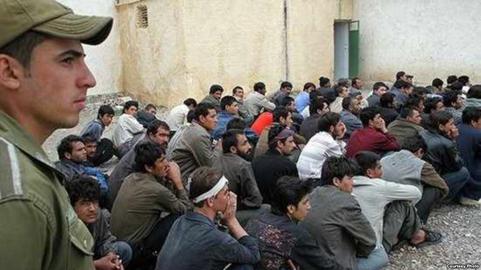An Iranian citizen journalist, who writes under a pseudonym to protect his identity, wrote the following article on the ground inside Iran.
Mohammad Babar is 15 years old and from Afghanistan. Like many other children from his country, he has tried to help his family survive by illegally crossing the border to work in nearby countries. But after leaving his birthplace for the first time and trying to cross into Iran, the border patrol caught Mohammad Babar and returned him to Afghanistan.
Babar lives in the northern Afghan province of Balkh. For the last three years his elder brother, who has been living in Turkey, has told him that job opportunities in Turkey are much better than in Afghanistan, which has tempted Mohammad Babar to go to Turkey via Iran. “My brother told me that he could not afford to pay the family’s expenses by himself, and that I must also go to Turkey and work,” he says. “So I left school and prepared to go.”
Balkh does not share a border with Iran, so anybody who wants to cross into Iran must first go to the Afghan capital of Kabul and then to the southwestern province of Nimruz — the center of human trafficking in Afghanistan. The road is dangerous because of the widespread presence of Taliban armed fighters in the province. Often, the Taliban plants land mines on highways, killing innocent civilians in revenge against the Afghan government.
Mohammad Babar spent eight days in terror. “I rode as a passenger in a car from Mazar-e Sharif to Kabul,” Babar says. “From there it took me another day to reach Zaranj.” In Zaranj, the capital of Nimruz, he says, a smuggler was waiting for him. “When he saw me he took me to a house outside the city.”
Babar says it was the same trafficker who had taken his elder brother to Turkey and that was why he trusted him. Then plan was for him to pay the trafficker $1,000 when he got him into Turkey.
But Babar never reached Turkey. He says that after spending a few days in a house in Zaranj he and a number of other Afghans who wanted to go to Iran were loaded into a Toyota van and driven, at a very high speed, through the scorched planes of Nimruz toward Pakistan. “There were more than 30 people in the van,” he says. “I was very afraid that, God forbid, I would fall out. Thank God we reached the Pakistani border and got out. The trafficker told us we had to go from the Pakistani border to Iran on foot.”
Bahram Haghmal, a civil rights activist in Nimruz province, told IranWire that traffickers move groups of 30 to 40 Afghans to Iran through Pakistan. According to him, human traffickers primarily use Mashkel and Raja in Pakistan as the main passageways because they are close to the Iranian province of Sistan and Baluchistan.
Walking, Thirsty and Hungry
Babar says he walked for three days to reach Iran, and most of the time he was thirsty and hungry. “At first there were 30 of us going from Afghanistan to Pakistan but after that our numbers increased and we were 40 when we climbed the mountains,” he says. According to him, 10 Pakistanis were also traveling with them. They were all arrested by the border guards a few hours after they entered Iran.
“The smuggler sneaked us past the first police station but when we reached the second station the police noticed that we had entered Iran illegally, fired shots in the air and arrested us,” Babar says. “They kept us in a dark house for a day and the next day they put us in a car and took us to another station.” According to him, the Iranian police did not beat or insult the children, but they did treat the adults badly. He says he was very afraid and cried noisily.
Most of the Afghan citizens Iran returns to their country have been smuggled into Iran via the Dogharoon border crossing between the two countries.
Abdol Ghader Rahimi, the president of the Afghanistan Independent Human Rights Commission in western Afghanistan, told IranWire that every day on average 10 lone children cross the border from Afghanistan into Iran. According to him, these children are suffering from psychological trauma and need support.
For the last few years, the United Nations Children's Fund (UNICEF) has been offering support to children who have been expelled from Iran through the border town of Islam Qala in Herat province. UNICEF workers give these children psychological counseling and arrange for them to return home safely without having to deal with human traffickers.
Mohammad Babar has also been helped by UNICEF. He is now back home, but it will not be easy for him to forget what he has been through.
Mohammad Balkhi, citizen journalist, Herat, Afghanistan
Related Coverage:
Smuggled Afghan Children Working as Street Peddlers, February 20, 2019
The Story of an Afghan Boy Trying to get to Iran, December 14, 2018
Iran’s Teenage Afghan Fighters, August 25, 2018
Who are the Main Victims of Human Trafficking in Iran?, July 23, 2018
Human Trafficking and Iranian Law, July 21, 2018
Why Is Iran the Chosen Pathway for Human Traffickers?, July 16, 2018
Child Trafficking by the Truckload, July 7, 2018
Wasted Youth: The Hidden Trash Collectors of Tehran, December 2, 2014
visit the accountability section
In this section of Iran Wire, you can contact the officials and launch your campaign for various problems

























comments